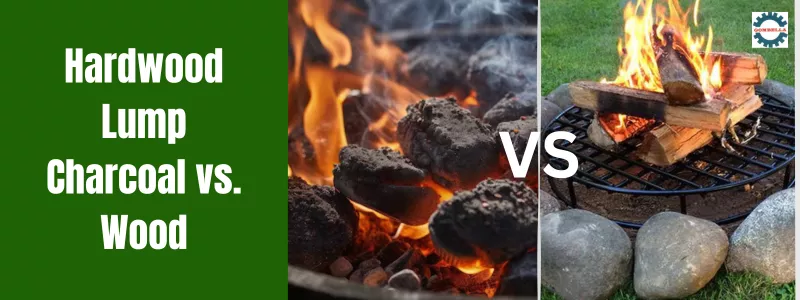-
-
Suite 1, Floor 2, Wing C, Alhaji Adenekan Plaza, Okota Road, Isolo, Lagos State, Nigeria
Blog Details

22
NovHardwood Lump Charcoal vs. Wood
Hardwood Lump Charcoal vs. Wood
Today, I’m excited to delve into the heart of the fire, exploring the nuances between two stalwarts of grilling and heating – Hardwood Lump Charcoal vs. Wood. As we gather around the warmth of our chosen source, whether it be for a cozy evening at home or powering the manufacturing processes that shape our world, let’s dissect the characteristics that make each option unique.
The Essence of Hardwood Lump Charcoal
At the heart of my fascination lies the enigmatic allure of Hardwood Lump Charcoal. Picture this: a dense, dark, irregular collection of charred wood pieces, the remnants of a slow, controlled burning process. As a connoisseur of the flame, I find myself drawn to the intense heat and distinct flavor that lump charcoal imparts to my culinary creations.
Flavorful Whiffs:
When it comes to grilling, the choice between hardwood lump charcoal and traditional wood can significantly impact the flavor of your dishes. The absence of additives in lump charcoal allows for a pure, smoky essence that subtly infuses the food, making it a favorite among barbecue aficionados. The minimal ash production ensures that your gastronomic masterpiece remains unadulterated, allowing the natural flavors to shine.
Precision in Heat:
One of the compelling aspects of hardwood lump charcoal is its ability to reach high temperatures quickly, offering a swift and efficient cooking experience. The irregular shapes of the charcoal pieces create air pockets, promoting better airflow and heat distribution. This translates to a more precise control over the cooking process, perfect for achieving that ideal sear on a steak or imparting a delicate smokiness to your vegetables.
The Environmental Steward:
For those with an eco-conscious flame flickering within, hardwood lump charcoal stands out as a sustainable choice. Produced from carefully selected hardwoods, the process involves controlled burning that minimizes carbon emissions. Additionally, the lack of additives or binders contributes to a cleaner burn, making it a more environmentally friendly option compared to some traditional charcoal varieties.
Embracing the Time-Honored Tradition of Wood
Now, let’s pivot our gaze towards the classic allure of using wood as our source of fire. The crackling sound, the earthy aroma, and the sight of logs transforming into glowing embers – wood evoke a primal connection to the elemental power of fire.
The Art of Slow Cooking:
Wood, with its lower energy density compared to lump charcoal, has a distinct advantage in the world of slow cooking. The gradual release of heat over an extended period allows for the development of complex flavors and tender textures, making it the preferred choice for those leisurely, all-day barbecues or smoking sessions.
Versatility in Choices:
Wood, with its myriad varieties, opens up a world of choices for the discerning fire enthusiast. Whether it’s the subtle sweetness of fruitwoods like apple or cherry or the robust smokiness of hardwoods like oak or hickory, the type of wood you choose can significantly influence the taste of your dishes. This versatility extends beyond the culinary realm, as different woods find applications in various manufacturing processes.
Back to the Roots:
Using wood as a fuel source provides a direct connection to our ancestral practices. There’s a primal satisfaction in splitting logs, arranging them in a carefully crafted fire pit, and watching as the flames dance and weave through the wood. For those seeking a more authentic and rustic experience, the choice of wood over charcoal becomes a matter of tradition and nostalgia.
Hardwood Lump Charcoal vs. Wood: Making the Decision
As we stand at this crossroads of choice, deciding between the efficiency of hardwood lump charcoal and the timeless allure of wood, it’s essential to consider the specific needs of your fire-centric endeavors.
Cooking Speed and Precision:
If your culinary adventures lean towards quick and precise cooking, with a focus on achieving specific temperatures, hardwood lump charcoal might be your preferred companion. The high heat output and minimal ash production make it an efficient choice for grilling and searing.
Flavor Infusion:
For those who relish the art of slow cooking and appreciate the nuanced flavors that different woods can impart to their creations, the aromatic embrace of wood might be the path to follow. Experimenting with various wood types can open up a world of culinary exploration.
Environmental Impact:
As stewards of the environment, our choices matter. Hardwood lump charcoal, with its sustainable production practices and cleaner burn, aligns well with eco-friendly values. However, responsibly sourced wood can also be a sustainable option, especially when considering the carbon-neutral cycle of growth and combustion.
Tradition and Aesthetic Appeal:
Sometimes, the decision boils down to the intangibles – the crackle of the wood, the smell of the smoke, and the visual appeal of a roaring wood fire. If these elements hold a special place in your heart, the choice becomes more about a connection to tradition and the aesthetics of the experience.
Conclusion
In conclusion,. Whether you find yourself drawn to the efficiency and precision of hardwood lump charcoal or the timeless allure of wood, the flame is a canvas waiting for your creative touch.
For Gombella Integrated Services, the choice is clear – the export of premium hardwood lump charcoal provides an opportunity for enthusiasts and manufacturers alike to experience the best of both worlds. As we continue to stoke the fires of innovation and tradition, let us revel in the warmth, the flavor, and the endless possibilities that each choice brings to our lives. Here’s to finding your fire and letting it burn bright!
Author's Details
gombella
Other posts by gombella